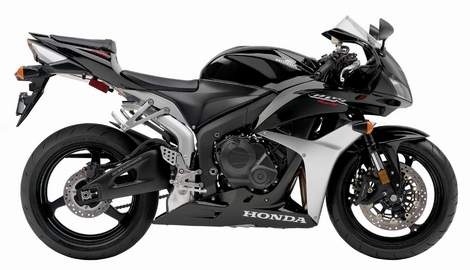Celebrating a Quarter-Century Of Honda’s ‘R’ Series Of Motorcycles


2007 sees the launch of the latest member of the ‘R’ series of Honda’s cutting-edge sports motorcycles – the CBR600RR. 25 years in the making, the Honda ‘R’ series of motorcycles were built to dominate the production classes in four-stroke road-racing. From the original CB1100R, this family of race-inspired machinery has culminated in the 2007 CBR600RR, which along with the CBR1000RR Fireblade are Honda’s ultimate ‘R’ designation machines.
1981
Honda CB1100R
The first ‘R’ series machine was the CB1100R of 1981. This was a 1062cc 16-valve air-cooled four-stroke machine, which had four-valves per cylinder and was hand-built and featured technology from Honda’s RS1000 race machine. Power output at the time was a very respectable 105bhp put to the rear wheel through a five-speed gearbox. The chassis parts and suspension were similarly ahead of their time. Looks were – for the day – extremely ‘racey’. In a time of naked muscle bikes, the CB1100R hid its muscle beneath either a full or half fairing, which hinted at its real intentions.
The reason to build the 1100R was simple: to win races and championships in the box-stock production racing events that were happening in the early 1980s.
1987Honda VFR750R RC30
In 1987 came the VFR750R – otherwise known as the legendary RC30. This machine was one of the first, which was – effectively – a race bike for the roads. This machine was built to dominate production four-stroke racing, especially the new-for 1988 World Superbike series. With its intricate V4 liquid-cooled 16-valve motor, pumping out around 115bhp, the machine was so far ahead of its time that it took the first two World Superbike titles in 1988 and 1989 with rider Fred Merkel and the Rumi Honda team. Other successes included numerous Isle of Man TT wins from its first year of racing there from 1988 onwards.
1991
Honda NR750
The 1991 NR750 was based in part on the racing NR500 and NR750 machines, which featured unique oval piston design technology. Unveiled as a travelling marshal’s bike at the 1990 Suzuka Eight-Hour race, the whole look of the NR750 was futuristic and space-age. The NRs showed what Honda could do and featured many technical innovations of the time, such as under-seat pipes, projector beam headlamps, fuel-injection and – of course – the oval pistons. Despite being an ‘R’ series machine, production racing was not the goal of the NR750, although a stripped version of the machine with modified pistons, camshafts and cylinder head pumping out around 155bhp – 30bhp up on standard – did capture a number of flying-lap and standing start World Records. Only 300 were made and were on sale for just one year, with each one costing around £38,000!
1992-presentHonda CBR900RR FireBlade
The CBR900RR FireBlade quite simply revolutionised large-capacity sportsbikes. Before the ’Blade, sportsbikes were heavy and fast, but with the CBR900RR, light was right and corners were meant for enjoying. The FireBlade was also really the first ‘R’ type for the masses being a mass-produced machine, rather than a limited-edition short-production run machine.
The original machine was an 893cc motorcycle, featuring many weight-saving parts. The CBR900RR proved a massive hit after launch, selling many thousands of units and being the best-selling machine in its class and being the overall best-seller in the UK for a number of years. The FireBlade has since grown in capacity, dropped the capital ‘B’ and developed into the CBR1000RR Fireblade and has won sales success as well as many international championship races including the 2006 British Superbike championship.
1994
Honda RVF750R RC45
In 1994 came the RC30’s successor – the RVF750R RC45. This bike was a completely new machine and was another limited-edition racer for the road, costing around £18,000 in the UK . In the World Superbike championship, the first win eventually came for long-time Honda rider Aaron Slight at Albacete in 1995 and the bike became a title threat from then on. The RC45 eventually took the World Superbike title for the Castrol Honda factory team in 1997 with American rider John Kocinski. Other titles included the American AMA Superbike title with Miguel DuHamel along with a Daytona 200 win, victories at the Suzuka Eight-Hour race a couple of Australian Superbike titles and a number of Isle of Man TT wins and podium placings.
2003-presentHonda CBR600RR
Since 2003 Honda’s middleweight sportsbike the CBR600 has had an ‘R’ series relative. With the Supersport 600 class being more hard-fought than ever, it was decided to introduce a sharper, more focused CBR600 to sit alongside the road-biased ‘F’ model. In came an all-new motor with fuel-injection, a ‘centre-up’ under-seat exhaust, looks from Honda’s RCV211V MotoGP bike and an almost identical rear suspension linkage and braced swing-arm to the GP racer. Updates continued into 2005, with 40% of the bike all-new for that model year. Biggest change was the inclusion of upside-down front-forks, subtle bodywork changes and updates to the fuel-injection and inlet ports to give the bike more mid-range power.
2007
The all-new Honda CBR600RR
This year it’s all change once more. Ram-air now comes from a centrally-mounted snout at the front, similar to Honda’s World Superbike-winning SP-2. The aesthetics are completely updated, as is the motor which is lighter and more powerful than ever before, benefiting from Dual Sequential Fuel-Injection. The new CBR is 22mm shorter than the older model and now has Honda’s Electronic Steering Damper fitted. All this helps to add up to a total claimed power output of 118bhp, pushing along just 155 kilos of machine!
The CBR600RR has successfully lived up to the ‘R’ model designation winning the World Supersport championship every year since introduction in 2003 and repeating that feat in the British Supersport series.
BMW Motorrad returns to world championship road racing BMW Motorrad Motorsport: New involvement in off-road racing.
Recent Posts
Copyright © 2013. Motorcycling Blog. All rights reserved


